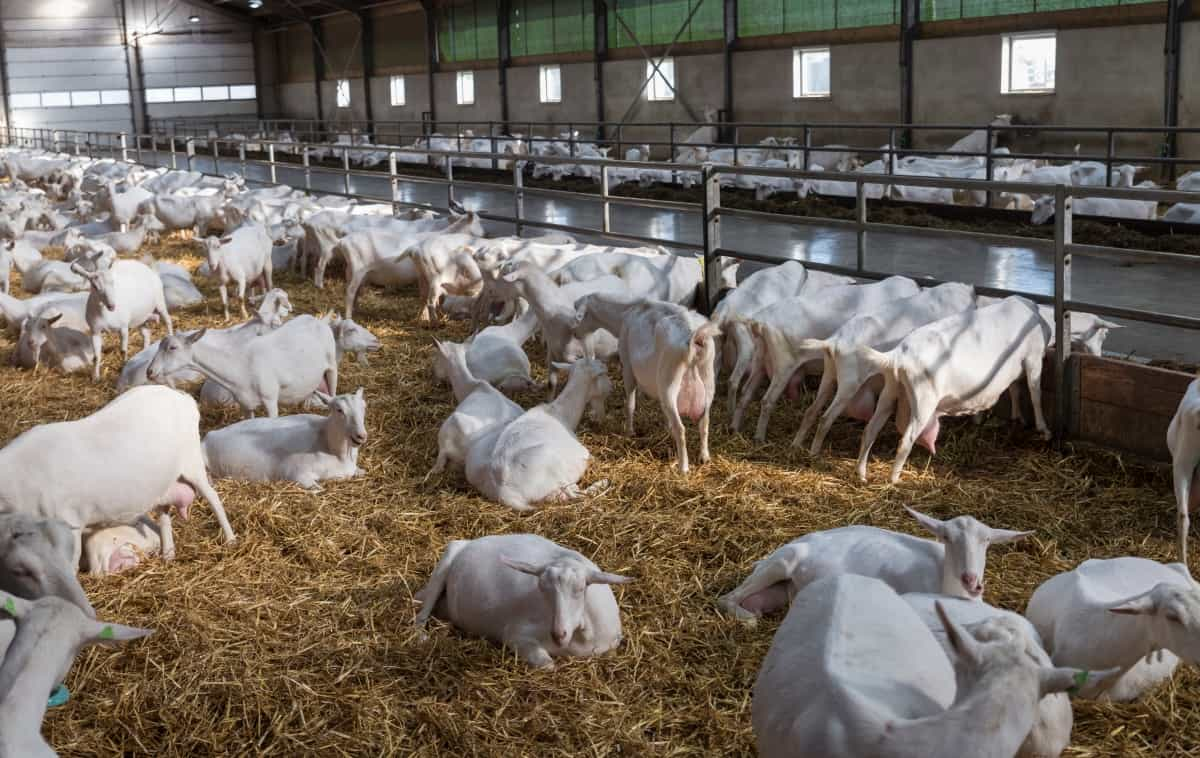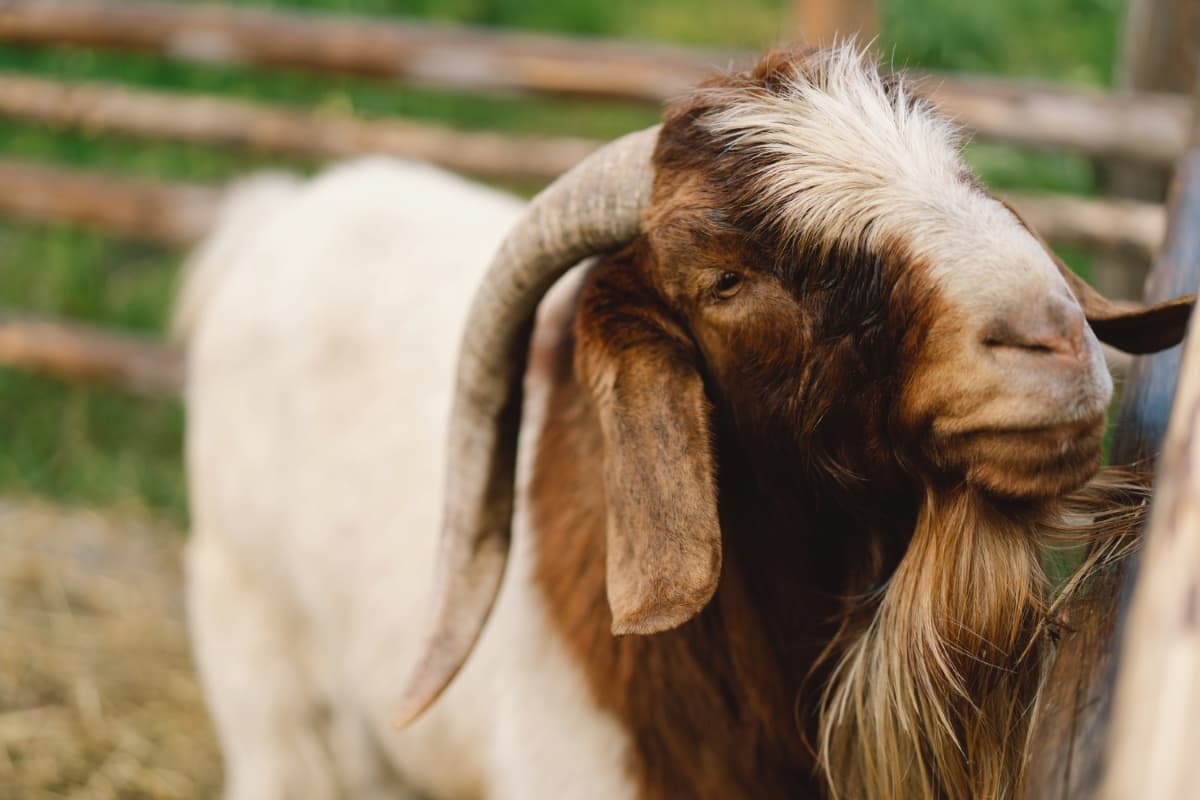Embarking on goat fattening necessitates a strategic blend of methods, a meticulously crafted feed formula, and a keen eye on costs. This intricate process involves optimizing the nutritional intake of goats to achieve optimal weight gain. This article will discuss the various aspects of goat fattening, such as housing, feeding, health, growth monitoring, and cost.

Goat Fattening Process
Introduction to Goat Fattening
Goat fattening is feeding goats intensively in feedlots until they reach the desired slaughter weight and fat deposition. Goat fattening aims to improve the meat quality and quantity of goats and increase the profitability of goat farmers. Goat fattening can be done in different ways, depending on the availability of feed resources, market demand, and climatic conditions.
Housing Requirements for Goats During the Fattening Phase
Goats need a comfortable and hygienic housing environment during the fattening phase. The housing should provide adequate space, ventilation, lighting, drainage, and protection from predators and harsh weather. The recommended floor space per goat is 1.5 to 2 square meters. The floor should be raised above the ground level and covered with bedding materials such as straw, sawdust, or rice husk.
The bedding need to be changed regularly to prevent dampness and odor. The housing should also have feeders and waterers that are easily accessible and clean. The feeders should be designed to prevent wastage and contamination of feed. The waterers should always provide fresh and clean water.
Various Feeding Methods Used in Goat Fattening
Goat fattening involves three main feeding methods: grazing, stall feeding, and mixed feeding. Grazing is the cheapest and most natural way of feeding goats, but it may need to provide more nutrients for fast growth and fat deposition. It also exposes goats to parasites, diseases, and predators. To meet nutritional requirements, grazing should be supplemented with concentrates or mineral blocks. Stall feeding is the most intensive and expensive method, but it ensures faster weight gain and better meat quality.
It reduces the risk of parasite infestation, disease transmission, and predation. However, it requires careful management of feed quality, quantity, hygiene, housing facilities, and waste disposal systems. Mixed feeding combines grazing and stall feeding, allowing goats to benefit from natural and artificial feeds. It reduces feed costs, improves palatability and digestibility, and improves health and welfare by providing exercise and social interaction. However, it requires careful planning and monitoring of feed intake and performance.
Feed Formulation in Goat Fattening (Different Components)
- Feed formulation is designing a balanced diet for fattening goats based on their nutritional needs, feed availability, and cost.
- Feed formulation involves selecting the appropriate ingredients, determining their proportions, and mixing them.
- The main components of a goat-fattening diet are forage, concentrate, minerals, vitamins, and water.- Forage: Forage is the bulk feed that provides fiber, energy, protein, and some minerals and vitamins to goats.
- Forage should constitute 60 to 70% of fattening goats’ total dry matter intake.
- Concentrate: Concentrate is the supplemental feed that provides energy, protein, minerals, vitamins, and other additives to goats.
- Concentrate should constitute 30 to 40% of fattening goats’ total dry matter intake.
- Minerals: Minerals are essential for various metabolic functions in goats.
- The most important minerals for fattening goats are calcium, phosphorus, magnesium, selenium, iron, copper, and zinc.
- Vitamins can be provided through green forage or commercial supplements added to the concentrate or water.
- The most important vitamins for fattening goats are vitamins A, D, E, and B complex.
- Water: Water is essential for hydration, digestion, absorption, circulation, and excretion in goats.
- Water should be provided ad libitum to fattening goats.
In case you missed it: Sheep Farming Vs Goat Farming: Pros, Cons, and Which is More Profitable?

Various Feed Ingredients Used in Goat Fattening Diets
| Feed Ingredient | Dry Matter (%) | Crude Protein (%) | Crude Fiber (%) | Total Digestible Nutrients (%) | Cost (USD/kg) |
| Alfalfa Hay | 90 | 18 | 30 | 55 | 0.2 |
| Corn | 88 | 9 | 3 | 85 | 0.3 |
| Barley | 88 | 12 | 5 | 80 | 0.25 |
| Oats | 88 | 11 | 10 | 75 | 0.2 |
| Soybean Meal | 88 | 44 | 7 | 75 | 0.5 |
| Distillers’ Grains | 90 | 28 | 10 | 80 | 0.15 |
| Molasses | 75 | 5 | – | 65 | 0.1 |
| Black Oil Sunflower Seeds | 90 | 16 | 25 | 70 | 0.4 |
| Goat Supplement | 90 | 20 | – | – | 0.6 |
Feed Conversion Ratio (FCR) and Its Significance in Goat Fattening
- Feed conversion ratio (FCR) measures feed efficiency in goat fattening.
- It is calculated by dividing the feed consumed by the weight the goats gain.
- For example, if a goat consumes 10 kg of feed and gains 2 kg of weight, the FCR is 10/2 = 5.
- The lower the FCR, the more efficient the feed utilization and the less the feed cost per unit of weight gain.
- The FCR can vary depending on the type and quality of feed, the breed and age of goats, the health and management of goats, and the environmental conditions.
- The average FCR for goat fattening ranges from 4 to 8.
Water Management in Goat Fattening
Water management is important for goat fattening, as water affects goats’ feed intake, digestion, metabolism, and health. Water should be provided ad libitum to fattening goats, as they can drink up to 10% of their body weight daily. Water should be fresh, clean, and free of contaminants. Water should be checked regularly for quality and quantity and replenished as needed. Water should be placed in clean and accessible containers that prevent spillage and contamination. Water should also be protected from freezing or overheating.
In case you missed it: Pros and Cons of Goat Farming: Every Beginner Should Know These

Health Management in Goat Fattening
- Health management involves the following practices:- Vaccination: Vaccination is the administration of vaccines that protect goats from common infectious diseases such as enterotoxaemia, tetanus, pneumonia, and anthrax.
- Vaccination should be done according to the recommended schedule and dosage.
- Deworming: Deworming is the administration of anthelmintics that kill or expel internal parasites such as roundworms, tapeworms, and liver flukes.
- Deworming should be done at regular intervals or based on fecal egg counts.
- External parasite control: External parasite control is the application of insecticides or acaricides that kill or repel external parasites such as ticks, lice, mites, and flies.
- External parasite control should be done as needed or based on visual inspection.
- Hoof trimming: Hoof trimming is the cutting or filing of excess hoof growth that can cause lameness or infection in goats.
- Hoof trimming should be done every 6 to Eight weeks or as needed.
- Sanitation: Sanitation is the maintenance of cleanliness and hygiene in goats’ housing, feeding, and watering facilities.
- Sanitation prevent the spread of diseases and parasites among goats.
- Sanitation involves regularly removing manure, urine, spilled feed, and bedding; disinfecting feeders, waterers, and equipment; and providing adequate ventilation and drainage.
Growth Monitoring During the Fattening Phase
Growth monitoring in the goat-fattening process is pivotal for optimizing outcomes. Precise record-keeping of weight gain, assessing body condition scores, and monitoring feed conversion rates are integral components. Scientific methods, such as ultrasound measurements and body composition analysis, enhance accuracy. Strategic adjustments to the diet can be made based on these data points, ensuring efficient muscle development and minimizing fat deposition.
Cost Aspects of Goat Fattening
Goat fattening is a profitable livestock enterprise that can provide income and food security for small-scale farmers. Goat fattening involves feeding goats with high-quality feeds to increase their weight and improve their meat quality. The cost aspects of goat fattening include the initial purchase of goats, feed costs, veterinary expenses, labor costs, and marketing costs. One example of goat fattening is the case of Mr. Ahmed, a farmer in Ethiopia who fattened ten goats for four months and sold them at a local market.
In case you missed it: 10 Common Mistakes to Avoid in Goat Farming for Healthy Profits

He bought the goats for 2,500 birr each and spent 1,200 birr per month on feed and 100 birr per month on veterinary services. He also hired a laborer for 300 birr per month to take care of the goats. He sold the goats for 4,500 birr each, making a total revenue of 45,000 birr. His total cost was 17,000 birr, so his net profit was 28,000 birr. His return on investment was 164%, which means he earned 1.64 birr for every birr he invested.
Conclusion
The goat fattening process demands a judicious blend of methods, precise feed formulas, and cost considerations. Strategic nutritional management is paramount for optimal growth.
- Feed Your Flock for Less: Top 10 Tips to Save on Chicken Feed
- Ultimate Guide to Ossabaw Island Hog: Breeding, Raising, Diet, and Care
- Hatching Answers: The Top 10 Reasons Your Chickens Aren’t Laying Eggs
- Eggs and Economics: Breaking Down the Cost of Raising Backyard Chickens
- Defend Your Greens: Proven Methods to Keep Iguanas Out of Your Garden
- Ultimate Guide to Cinnamon Queen Chicken: A Comprehensive Guide for Beginners
- Ultimate Guide to California Tan Chicken: Breeding, Raising, Diet, Egg-Production and Care
- Ultimate Guide to Marsh Daisy Chicken: Breeding, Raising, Diet, and Care
- 10 Types of Chicken Farming Businesses You Can Start for Profits